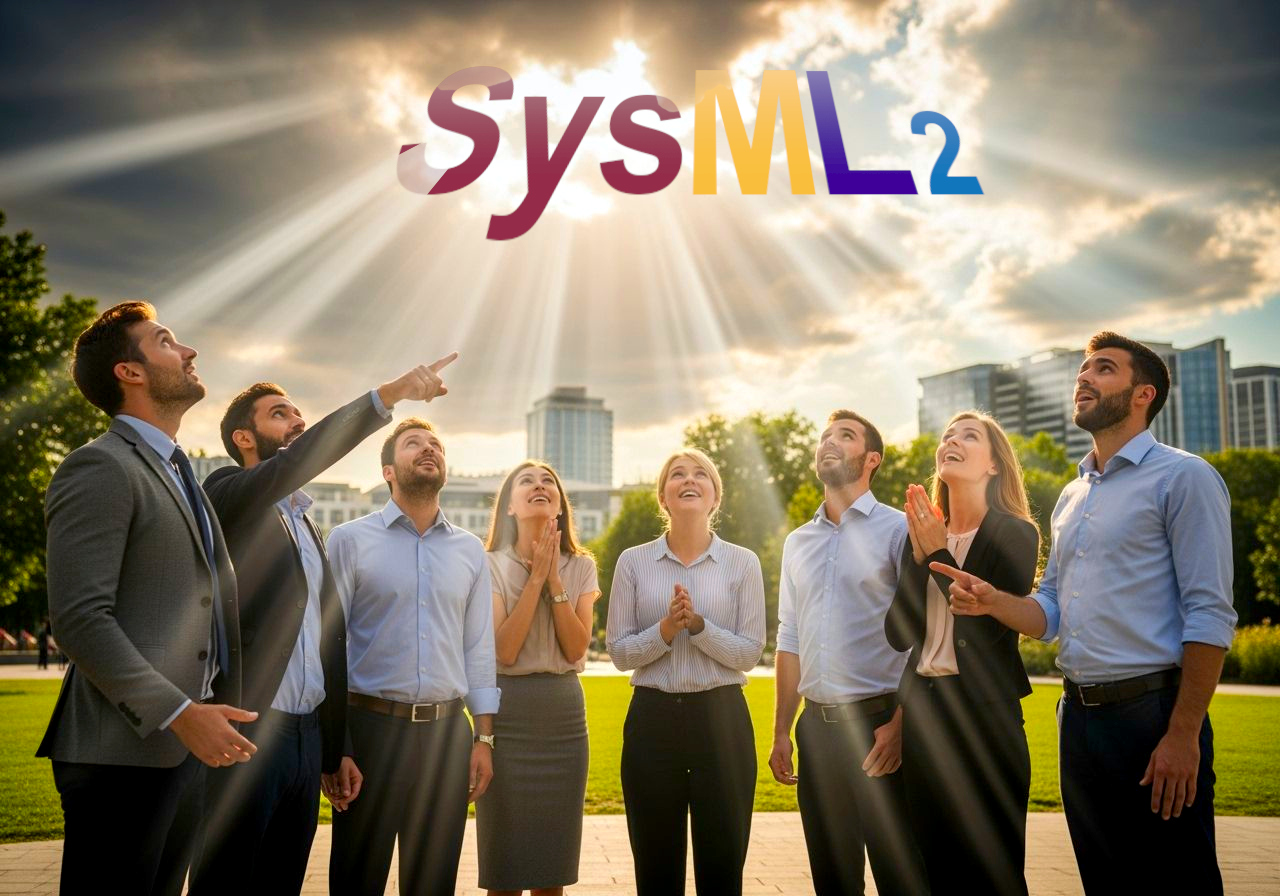SysML 2.0 Officially Released: A New Era in Model-Based Systems Engineering (MBSE)
Author: Stephan Roth | Category: MBSE | Published on: July 29, 2025 | Updated on: August 24, 2025
Big news for the systems engineering community: On July 21, 2025, the Object Management Group (OMG) announced the final adoption of SysML v2 (Systems Modeling Language™ Version 2.0) as an official international standard. This marks a major milestone after nearly seven years of development by the SysML v2 Submission Team (SST).
Sysml v2 Is a Profound Overhaul
 The first version of the modeling language for complex systems, SysML 1.0, was released in September 2007. Since then, the language has been used in many engineering projects in various domains and industrial sectors. A lot of experience with SysML 1.x has been gained over the last two decades. However, technological progress, ever-increasing system complexity, and new approaches in systems engineering such as digital twin, digital thread, AI-assisted MBSE, and product line engineering have pushed the limits of what SysML 1.x could support. The predecessor was still based on the semi-formal Unified Modeling Language (UML) which has its roots in object-oriented software development in the 1990s. As a result, it can hardly meet the future needs in modern systems engineering. SysML v2 addresses these challenges with a complete architectural overhaul and a new foundation. UML has been removed, instead the language is based on a new formal metamodel named Kernel Modeling Language™ (KerML™).
The first version of the modeling language for complex systems, SysML 1.0, was released in September 2007. Since then, the language has been used in many engineering projects in various domains and industrial sectors. A lot of experience with SysML 1.x has been gained over the last two decades. However, technological progress, ever-increasing system complexity, and new approaches in systems engineering such as digital twin, digital thread, AI-assisted MBSE, and product line engineering have pushed the limits of what SysML 1.x could support. The predecessor was still based on the semi-formal Unified Modeling Language (UML) which has its roots in object-oriented software development in the 1990s. As a result, it can hardly meet the future needs in modern systems engineering. SysML v2 addresses these challenges with a complete architectural overhaul and a new foundation. UML has been removed, instead the language is based on a new formal metamodel named Kernel Modeling Language™ (KerML™).
What’s New in SysML 2.0?
SysML 2.0 comes with some significant changes and groundbreaking innovations:
- KerML™, the foundation of SysML v2 and possibly other modeling languages in the future, provides a precise and formal semantic, defined in mathematical form (first-order logic, also called predicate logic).
- In addition to a graphical notation, there is now also a textual notation that can be used to describe models or portions of a model.
- The paradigm of distinguishing between definition and usage, which was already there in SysML 1.x, has now been implemented much more consequently in SysML v2. For example, there are now also requirements or use cases as definitions and usages.
- 4D modeling capabilities: Systems or parts of a system modeled in SysML 2.0 can have a spatial extent. So-called timeslices and snapshots support the modeling of their temporal aspects, e.g., the life cycle of a system.
- Part of the new language standard is also the specification of a standardized interface (Systems Modeling Application Programming Interface (API) and Services) for accessing and manipulation of the model data in a model repository. This allows the model data to be queried, created, updated or deleted using virtually any software tool (e.g., Spreadsheet or a Large Language Model (LLM)).
- SysML v2 supports Feature-Based Product Line Engineering (PLE) according to ISO/IEC 26580:2021.
- Improved, flexible viewpoints and views, according to ISO/IEC/IEEE 42010:2022.
- A comprehensive set of extensible domain libraries, such as mathematical and logical functions, as well as quantities, units, and dimensions (ISO/IEC 80000 Parts 1–13 International System of Quantities).
With the release of SysML 2.0, the longstanding MBSE vision of the system model as a Single Source of Truth, i.e., as the only relevant source of all engineering data, is now more achievable than ever.
What's Next?
SysML version 2.1 will certainly not be long in coming; the responsible Revision Task Force (RTF) at OMG has already begun its work. Apart from that, the release of the final SysML 2.0 certainly also means that many modeling tool vendors will now launch their SysML v2 tools which they have already in the starting blocks. For companies that already own system models created with SysML 1.x, tools that can transform these existing models to SysML v2 are likely to be of interest. These transformation rules are defined in Part 2 of the specification (see References).
Engineers will need to upskill to make the most of SysML 2.0. The training and consulting company oose eG in Hamburg (Germany) offers training courses for this purpose (open or in-house trainings). Another attractive option is the SysML v2 Learning Club, which allows learners to explore the new possibilities of SysML v2 online and at their own pace.
The future of MBSE is here. Exciting times ahead!
References
- OMG Systems Modeling Language™ (SysML®) Version 2.0, Part 1: Language Specification
- OMG Systems Modeling Language™ (SysML®) Version 2.0, Part 2: SysML v1 to SysML v2 Transformation
- Kernel Modeling Language™ (KerML™) Version 1.0
- Systems Modeling Application Programming Interface (API) and Services Version 1.0
- The OMG® Systems Modeling Community at GitHub